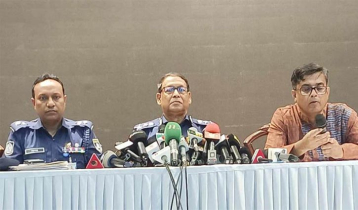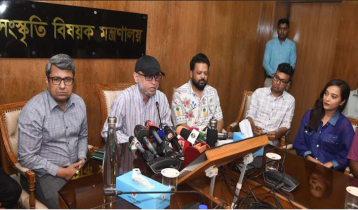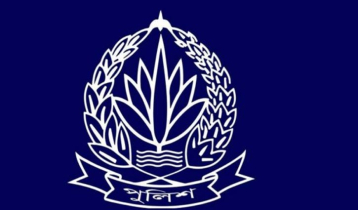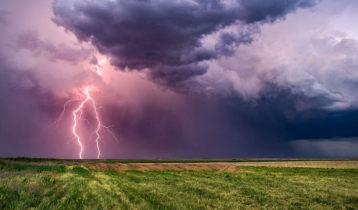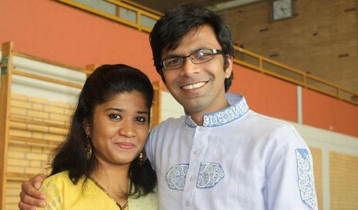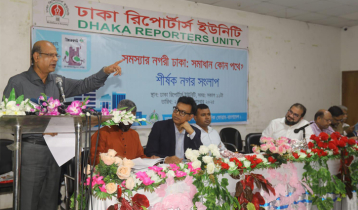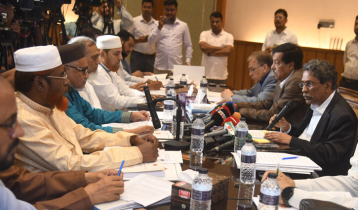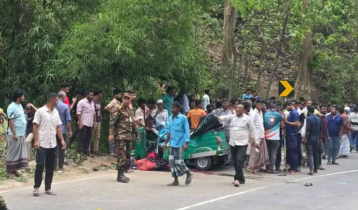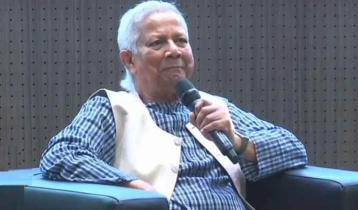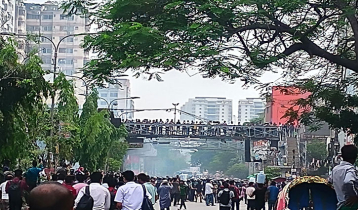Hilsa scarcity, astronomical prices shake Pahela Baishakh culture
Manzurul Alam Mukul || risingbd.com
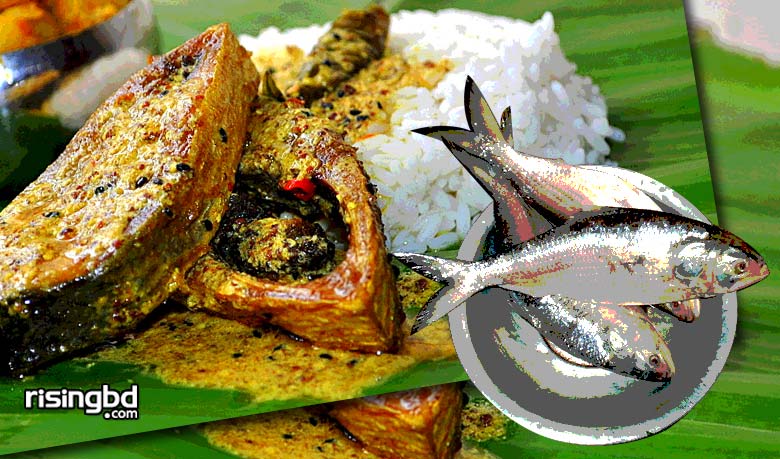
For the first time in the history, a debate has been created on the practice of eating Panta-Ilish on Pahela Baishakh (Bangla New Year).
There is a tradition, in the dawn of Pahela Baishakh, people of Bangladesh and West Bengal of India welcome the New Year with Panta (wet rice) Ilish. It was learnt that the culinary delight of a Hilsa dish is an inseparable part of Bangla New Year celebrations but there arises a question due to scarcity of hilsa fish and its astronomical prices in the market.
Prices of Hilsa have skyrocketed ahead of Pahela Baishakh when consumption of the fish usually shots up. Buyers allege price gouging by rogue traders because of the growing demand for the fish.
It is also learnt that markets have been flooded with imported Chokori and Chandria fishes which almost look like Bangladeshi hilsa.
However, the tastes are not as rich as that of the hilsa and consumers are mistaking them with Bangladesh’s most delicious fish.
In the kitchen markets, vendors are also deceiving the consumers who prefer the fish for cheaper rates being oblivious of its purity.
In the circumstance, many people and the authorities of many organizations and institutions have announced that they would keep Hilsa out of Pahela Baishakh menu. Some organizations have forced a restriction on `panta-ilish` on the grounds amid the festival of Pahela Baishakh.
Even, guests at the Ganabhaban will not be served Hilsha on Pahela Baishakh as Prime Minister Sheikh Hasina has decided to keep it out of her menu.
It is an effort to preserve the national fish population, said her Press Secretary Ihsanul Karim on Tuesday.
The Ganabhaban, the prime minister’s official residence, will serve fried aubergine, eggs and chicken curry with Khichuri – a hotchpotch of rice and lentils.
Experts say that the practice Panta- Ilish has no roots in a thousand years of Bengali tradition and it is hard to find any reference to Panta-Ilish being a Bengali food delight.
In support of their opinion, experts mention a collection of songs and poems in Prakrit - Prakrit Poingal - dating back to the 14th century that has a reference to "pure `ghee` (clarified butter) and hot rice".
A couplet says `the husband of a woman who serves him hot rice, ghee made from cow milk, `mourola` fish curry and `paat` herbs is truly blessed`.
The Brihaddharma Puran recommends fishes such as `rui`, `punti`, `sol` and white, scaly varieties.
Jimut-bahan speaks of Hilsa fish oil as well. But no ancient text recommends the eating of `panta-ilish`.
This upstart practice of eating Hilsa on that day is of recent origin. It is the brainchild of some shopkeepers who put up stalls during the New Year celebrations at Ramna or the Mangal pageant of the Faculty of Fine Arts at the Dhaka University, both of which draw large crowds.
The practice they introduced was soon adopted by others. The ritual of eating Hilsa has nothing to do with ancient Bengal or the Bangla New Year.
In Odisha, there is a popular saying that `Machha khaaiba Ilishii, chakiri kariba polisi`, which means that eating hilsa and getting a job in police department are of equal status, meaning that eating hilsa is respectable.
Bangalis are very much sensitive with this fish, especially in a rainy or a cold day. Bangalis can’t control themselves if they get ilish maach bhaja (fry), with the oil coming out of those fish, with rice, onion and green chili. It is called hilsa fish fry, one of the most popular Bengali fish fry items. Shorshe Ilish, a dish of smoked ilish with mustard seeds, is also another popular item. It is said that Bangalis can cook ilish in more than 50 ways. Some other common hilsa menus are curd and brinjal (eggplant) curry with fish, muri ghonto, Panta Ilish, etc. Ilish can be cooked in very little oil since the fish itself is very oily.
Hilsa is one most important fish in the world in terms of food value and cultural importance. It is an obvious food in a good number of festivities in Bangladesh and India.
Hilsa is an English word and in Bangla it is called ilish. It is the national fish of Bangladesh, also called the king of all fishes. Not only in Bangla, hilsa fishis considered to be one of most favorite and delicious fish in the world. The fish is also popular food amongst the people of South Asia and in the Middle East.
Hilsa fish is a fish of saltwater and there are five types of hilsa can be found worldwide. It is found in rivers, estuaries and seas near to Bangladesh, Myanmar, India, Pakistan, and the Persian Gulf area. It also can be found in the Tigris and Euphrates rivers in and around Iran and Iraq.
Available surveys say, about 60 percent of the world`s hilsa fish is found in Bangladesh. Other 15 percent-20 percent are caught by India and Pakistan and rest 5 percent-10 percent are caught by Malaysia, Thailand, China, Vietnam and Sri Lanka.
The hilsa`s contribution to total fish production in Bangladesh is 11 percent, which is highest as the single fish species in the country. It is providing direct employment to 3.5 lakh fishers and indirect employment to an additional 2.5 million people in trade and transport.
In 2008-09 fiscal, the production of hilsa in Bangladesh was only 2.99 lakh tonnes while the production of the particular species jumped to 3.51 lakh tonnes in 2012-13 fiscal, and the production went up about 4 lakh tonnes in 2013-14 due to different steps taken by the authorities. Apart from consumption at home, hilsa fish caught in Bangladesh are exported to India, Middle East, Europe and America.
However, hilsa is also caught from the sea. But those caught from the sea are not considered to be as tasty as those caught from the rivers Padma, Meghna and Jamuna.
Hilsa can grow up to 60cm in length with weights of up to 3 kg. The body of hilsa is very dense and fairly deep with dorsal and ventral profile equally curved. It equally spread medium-sized scales give a metallic silver shine. Female hilsa are usually larger than males. The hilsa is known to be a fast swimmer and can cover even 60 kilometers at a time. It attains maturity in 1 to 2 years. The species filter feeds on plankton and by grubbing muddy bottoms.
Generally, it is a fish of sea. But during breeding period (Sept-Oct) it comes to the big rivers and lays eggs there. The most amazing fact about hilsa is that it lays eggs in the large river especially in Padma-Meghna-Jamuna delta at Bay of Bengal. The young fish returning to the sea are known as jatka, which includes any hilsa fish up to 9 inches long.
Once there was a local customs, ilish were not harvested between Lakshmi Puja and Saraswati Puja, but at present the old traditions are being abandoned.
Fishermen have been ignoring calls to at least leave the juvenile `jatka` alone to repopulate the species. The advent of finer fishing nets and advanced trawling techniques, and environmental degradation of the rivers, has worsened the situation.
Huge number fishermen are now employed in catching hilsa in hope of earning money as it is very pricy comparing to other fishes. Due to over and unplanned fishing, the species is heading towards extinction in certain regions. Furthermore, the changes brought about by global warming have led to a gradual depletion of the ilish`s breeding grounds, reducing populations further. As a result, price of the fish is going to exorbitant levels day by day, and we are being deprived of enjoying of taste of hilsa.
In a bid to protect the young hilsa less than 10 inches in length and create awareness about the protection of species, like the previous years, The Ministry of Fisheries and Livestock is observing The Jatka Preservation Week-2015 throughout the country from April 1 to April 7.
With the support of some donor agencies, the government has been implementing different projects in 19 coastal and riverside districts.
Under the jatka preservation, alternative employment for the fishermen and research project, the government is providing food assistance and alternative jobs to a large number of fishermen. 40 kgs of rice is being given to each family, side-by-side providing other supports to fishermen and women during the fishing ban period for livelihood in a bid to reduce pressure on fish stocks.
The government`s Hilsa Fisheries Management Action Plan (HFMAP) prohibits fishers from catching brood stock and juvenile hilsa in five sanctuaries in the Padma-Meghna rivers. Besides, jatka catching, transportation, marketing and sales are restricted from November to June each year with an 11-day country wide ban on its catch in October. For this purpose, the government conducts mobile courts and drives during the period.
But it is the reality that the steps taken by the authorities are not enough to address the declining biodiversity of Hilsa. It is unfortunate that when the government is implementing different projects and initiatives to protect hilsa then every day we get many news items on huge amount of jatka recovering by low enforcing agencies, jatka catching and jatka sales in markets.
In a risingbd investigation, it is learnt that about 40,115 fishermen are getting food assistance in Chandpur district, the capital of hilsa.
But the unofficial sources say that there are over 70 fishermen in the district and rest of them are being deprived of food assistance.
On the other hand, who are getting food assistance in the district cannot maintain their families. It becomes impossible for a family of 6/7 members to run a month with 40kgs of rice. There is an also allegation that, most of the fishermen get less than 40 kgs of rice due to lack of proper allocation, misappropriation, etc. As a result, most of the fishermen are to catch jatka for livelihood options during the ban period.
Local experts also say the law enforcing agencies conduct mobile courts and drive during the period to stop jatka fishing. But it is not sufficient due to manpower shortage and lack of instruments. As a result, the law enforcing agencies and concerned authorities are also failing to control it.
Only the government initiatives are not enough to protect hilsa rather than all people belonging to all professions, including fishermen, businessmen, public representatives and media will come forward. Basically, we need a social movement to maintain production of Hilsa.
National fish hilsa has a close relation with the food-habit and culture of Bengalis. The contribution of Hilsa to employment generation, ensuring supply of protein and country`s economic development is very important.
So, there needs the proper implementation of different projects taken by the government, and more pragmatic stets to address the declining biodiversity of hilsa and other fish in the Padma-Megna river-estuarine basin and to improve the resilience of the fishers` community in the face of reality and unpredictable climate change effects. Side-by-side, all people including professionals should come ahead to protect the species.
risingbd/DHAKA/April 14, 2016
risingbd.com


